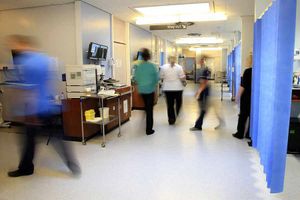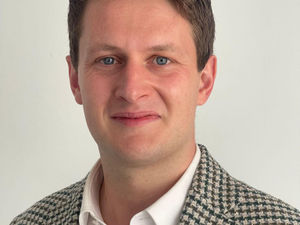Shropshire NHS transformation plan launch challenged by councils
Service changes and cuts to health and care services across Shropshire and Telford & Wrekin were formally unveiled today - and immediately attacked by Shropshire's two largest councils.

Too vague and not properly developed – that is the damning verdict given today about the NHS plan by both councils serving Shropshire.
Telford & Wrekin Council and Shropshire Council agree there is too much emphasis on the future of the county's hospitals and not enough on how basic GP services can be sustained when finances are incredibly tight.
Today both councils refused to endorse the draft sustainability and transformation plan, otherwise known as STP, in its present form.

Shropshire's draft STP, sets out a number of changes and cuts, designed to tackle the predicted deficit in the county's health and social care services, expected to be £131.4 million by 2021.
The STP outlines how the NHS plans to transform and make financially sustainable all health services in Telford and Wrekin and Shropshire, including for hospital services and community services.
The STPs are being created by regions across the country and are seen by critics as a way of cutting funds from the NHS.
Read the full plan here
Telford & Wrekin Council says it has a lack of confidence in the financial projections and the reliability of the rationale for future cost reductions.
It also says significantly more resources should be put into prevention and the reconfiguration of community and primary care services, rather than these being concentrated on the reconfiguration of hospital services.
These concerns were echoed by Shropshire Council, which says it has a lack of confidence in the plan.
Malcolm Pate, leader of Shropshire Council, said: "NHS England have instigated a 'launch' of the STP, which suggests the plans have been fully worked through and agreed by all parties.
"Unfortunately, this is not the case, as it is the opinion of both Shropshire Council and Telford & Wrekin Council that some elements of the document need developing."
Meeting your doctor via video link and attending 'community hubs' rather than hospital outpatient departments – this is part of the vision for the future of the NHS in Shropshire.
But while the sustainability and transformation plan runs to 73 pages, it is short of detail.
And, after three years of talking about Shropshire's A&E departments in a Future Fit process costing £3 million, there is still no clear plan for the future of emergency units in our county.
Both Telford & Wrekin and Shropshire councils today criticised the sustainability and transformation plan, or STP, for being too broad brush. Leaders at both councils says it fails to deliver an adequate plan for health care on the ground.
NHS bosses, led by the chief executive of Shrewsbury and Telford Hospitals NHS Trust Simon Wright, were given the task of creating a plan that would improve care in the county but also target a predicted funding gap of more than £130 million within the health service. It is a process being repeated across the country.
Shropshire's plan speaks of how £74 million might be used "differently and more effectively" but does not go into detail about how this will happen.
Measures in the proposals include the Future Fit reconfiguration of A&E services at Royal Shrewsbury Hospital and Princess Royal Hospital in Telford.
Health bosses hope to create one hospital specialising in emergency care and the other in routine surgery – but still fall short of saying where the single unit should be based.
Plans to close the A&E at either RSH or PRH are estimated to save about £22 million a year, although it will require £300 million of capital to complete.
The plan also proposes a number of measures to allow patients to be seen closer to home, including the idea of having 35,000 outpatient appointments a year carried out via video link. It is also hoped that 27,218 hospitals appointment will not be needed and carried out in the community instead. The STP gives no further detail about the kind of appointments that could be affected.
Health bosses say they are also working with Health Education England to design new roles and train more staff so they can address the staffing shortages. There is currently a high vacancy rate in medical staffing and the recruitment of GPs is making the future staffing of primary care services more "problematic".
The report also says a review has been launched to see if orthopaedic services should be continued provided on three separate sites. Orthopaedic services are currently provided at Robert Jones and Agnes Hunt Orthopaedic Hospital in Gobowen, at Royal Shrewsbury Hospital and Princess Royal Hospital in Telford.
The STP claims that the county is spending more on the services than areas of similar size.
Mr Wright said: "NHS services in the area have some real strengths and our staff are dedicated to first class patient care.
"However the way services have historically evolved they are no longer able to meet the demands of the future, with ever increasing demand, and we need to change and support new solutions.
"We want to talk to as many people as possible about how we can help the population to become healthier with the resources available.
"We will have to be innovative and the STP details how we think the changes can be achieved in an area that is hugely diverse, with many people living in relatively deprived urban communities. We also have an enormous geographical area with people living in remote rural areas where journey times are long and public transport poor.
"This has helped shape our proposed neighbourhood-based approach, with teams bringing together GPs, social care professionals, community nurses, therapists, mental health workers and members of the voluntary sector to work far more closely together.
He added: "We also need to continue with our plans for safer and more sustainable hospital services. These are more developed due to all the work we have done through the NHS Future Fit programme, and the large amount of public engagement that has gone on over recent years.
"The STP is not a final detailed plan of how we want to change things. It represents the views and aspirations of the organisations involved. We will take all of these ideas to the patients who use our services and our own workforce. We'll be talking more about this in the coming months.
"Any proposed changes will be subject to engagement, and a consultation on NHS Future Fit is already planned. We will only take forward proposals which will support the long-term future of our NHS and will benefit our patients."
The next stage will be to refine the ideas further through engagement with local communities, the NHS workforce and stakeholders.
Any comments can be sent to shropstandwstp@nhs.net
Statement by The Shropshire and Telford & Wrekin STP:
The Sustainability and Transformation Plan (STP) for Shropshire and Telford & Wrekin sets out how the health and care system can remain fit for the future, help patients to become healthier and respond effectively to the growing demands being placed upon it.
It sets out ambitious plans for transformed neighbourhood services; safe and effective hospital care; ways in which new technology can be harnessed; and how gaps in the workforce can be filled and financial resources better spent.
The plan represents the thoughts and ambitions of the organisations involved who have worked together to develop the STP. The next stage will be to refine the ideas further through engagement with local communities, the NHS workforce and stakeholders.
STPs are a national initiative, and England is divided into 44 areas known as "footprints". The Shropshire and Telford & Wrekin STP has brought together partners across the local area (including Mid Wales) to collaborate on challenges faced by the NHS in order to deliver the NHS Five Year Forward View of better health, patient care and improved efficiency.
Simon Wright, Chief Executive of Shrewsbury and Telford Hospitals NHS Trust (SaTH) and the lead for the STP said: "NHS services in the area have some real strengths and our staff are dedicated to first class patient care. However the way services have historically evolved they are no longer able to meet the demands of the future, with ever increasing demand, and we need to change and support new solutions.
"We have set out four main priorities, some of which are more developed than others. Now we want to talk to as many people as possible about how we can help the population to become healthier with the resources available."
The four priorities are:
Going Local – how we will tackle the causes of poor health in local communities. Bringing care closer to where people live, helping people avoid preventable conditions and managing long-term conditions. This is especially important in our rural areas. A neighbourhood model is being developed as the basis of providing better services for patients who require professional help but not hospital care
Safe and Effective Hospital Care - 300 clinicians have helped develop plans for hospital care. They are the people who deliver NHS services day-in-day-out. A large amount of public engagement has already been carried out as part of the NHS Future Fit programme
Into the Future – new technologies offer enormous opportunities for helping people access help and support for their health and to manage long lasting illnesses
Staffing and financial challenges – We want to design new roles for our healthcare professionals and train more doctors, nurses and other staff. We also believe £74 million could be used more effectively than at present, and we need to improve efficiency
Simon said: "We will have to be innovative and the STP details how we think the changes can be achieved in an area that is hugely diverse, with many people living in relatively deprived urban communities. We also have an enormous geographical area with people living in remote rural areas where journey times are long and public transport poor. This has helped shape our proposed neighbourhood-based approach, with teams bringing together GPs, social care professionals, community nurses, therapists, mental health workers and members of the voluntary sector to work far more closely together."
"We also need to continue with our plans for safer and more sustainable hospital services. These are more developed due to all the work we have done through the NHS Future Fit programme, and the large amount of public engagement that has gone on over recent years."
Simon added: "The STP is not a final detailed plan of how we want to change things. It represents the views and aspirations of the organisations involved. We will take all of these ideas to the patients who use our services and our own workforce. We'll be talking more about this in the coming months.
"Any proposed changes will be subject to engagement, and a consultation on NHS Future Fit is already planned. We will only take forward proposals which will support the long-term future of our NHS and will benefit our patients."
Any comments can be sent to shropstandwstp@nhs.net
People can also ring the Patient Advice and Liaison Teams of any of the partner organisations in England – details are available through websites.
Statement by Telford & Wrekin Council:
Telford & Wrekin Council has stressed that it has not endorsed the NHS's draft Sustainability and Transformation Plan (STP), published today which lays out plans for healthcare across Telford and Wrekin and Shropshire.
The STP outlines how the NHS plans to transform and make financially sustainable all health services in Telford and Wrekin and Shropshire, including for hospital services and community services.
The Council has not been asked to endorse the STP and would not do so in its current form.
Telford & Wrekin has made a number of responses to the draft plan including:
A lack of confidence in the financial projections and the reliability of the rationale for future cost reductions
Significantly more resources should be put into prevention and reconfiguration of community and primary care services, rather than these being concentrated on reconfiguration of hospital services
Leader Councillor Shaun Davies had publicly urged the STP's Board to publish the draft STP which was widely supported by the Board.
He said: "I am glad that this is now available for people to see because it is vital that future plans across the whole local health economy are as transparent as possible.
"Given the Future Fit review into hospital services which threatens to close the PRH's Women & Children's Unit and A&E and move these services to Shrewsbury, this is even more important.
"We agree that the STP needs to secure more resources for Shropshire, Telford and Wrekin and that there needs to be significantly more resources put into prevention and reconfiguration of community and primary care services, rather than focussing these on reconfiguration of hospital services.
"The plans for GP services and local community care will play a key role in reducing pressure on hospital services.
"Our position remains that we believe there should be two A&Es covering Shropshire and Telford & Wrekin and that the £28m Women's & Children's Unit at PRH that opened two years ago was based on clinical need and that need has not altered.
"Equally issues that are constantly raised with councillors, such as the struggle most people have just to get a GP appointment in the borough, need sorting."
Statement by Shropshire Council:
The Sustainability and Transformation Plan outlines how the NHS plans to transform and deliver financially sustainable health services in Shropshire and Telford & Wrekin, including hospital and community services.
The local STP has been discussed for several months with health, local government, regulatory bodies and the third sector. The idea has been to collaboratively prepare a credible plan for delivering better services whilst also identifying cost savings. The work sees the UK divided into 44 geographical 'footprints'; locally we are designated the Shropshire and Telford & Wrekin footprint.
Each footprint will have different priorities, with varying geographical, political and social considerations. It is the recognition that a 'one-size-fits-all' approach to health and social care is not possible, that makes the STP different.
Every footprint has been asked to provide details of the work undertaken and their future plans, with this information being used by central government to identify best practice and support improvements. These plans have then been developed by the parties involved, and it is the view of the councils that the documents are still very much in development and should be seen as draft versions of the final plans.
Malcolm Pate, Leader of Shropshire Council, said: "NHS England have instigated a 'launch' of the STP, which suggests the plans have been fully worked through and agreed by all parties. Unfortunately, this is not the case, as it is the opinion of both Shropshire Council and Telford & Wrekin Council that some elements of the document need developing."
The main issues leave both councils with a lack of confidence in the financial projections and the reliability of the rationale for future cost reductions.
Furthermore, it is the shared view that significantly more resources should be put into prevention and reconfiguration of community and primary care services, rather than reconfiguration of hospital services.
Neither council has endorsed or been asked to endorse the full STP at this point in time and, siting the issues above, are unlikely to approve the STP in its current form.




